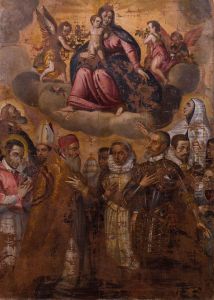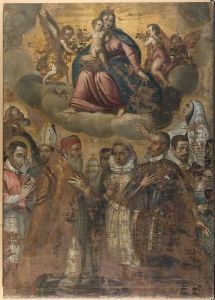Grazio Cossali Paintings
Grazio Cossali was an Italian painter of the late-Renaissance or Mannerist period, active mainly in Brescia and its surrounding territories. Born in 1563 in Orzinuovi, a small town in the province of Brescia, Lombardy, Cossali was initially a pupil of Giovanni Battista Moroni, a prominent portraitist based in Bergamo. Cossali's early works indicate that he absorbed Moroni's attention to detail and his acute ability to render the human figure with a degree of realism that was significant for that period.
After his initial training, Cossali's style was further influenced by the work of more mannerist artists such as the Campi brothers, Giulio, Antonio, and Vincenzo, from Cremona. Cossali's work, however, is most notably linked to the Brescian school of painting, which was defined by a blend of Venetian colorism and Lombard naturalism. This school included such masters as Moretto da Brescia and Romanino, whose influence can be seen in Cossali's use of color and composition.
Cossali's oeuvre includes religious themes, which were typical of the time, and his paintings often featured dramatic expressions and complex iconography. He was also known for his frescoes and altarpieces. Among his notable works are 'The Miracle of the Loaves and Fishes', located in the church of San Giovanni Evangelista in Brescia, and 'The Adoration of the Magi' in the church of Sant'Alessandro in Brescia. Cossali's works are characterized by their dynamic composition, energetic figures, and rich color palette.
Grazio Cossali's career was marked by his role in the decoration of various churches and public buildings, making him a significant figure in the cultural landscape of Brescia during the Counter-Reformation. His paintings reflected the religious and cultural shifts of the time, and they served both as devotional images and as a means to educate the public about the narratives of Christianity.
Cossali died in Brescia in 1629, leaving behind a legacy that has been appreciated for its contribution to the evolution of late Renaissance painting in Northern Italy. His works continue to be studied for their stylistic qualities and for their representation of the era's religious fervor and artistic trends.

